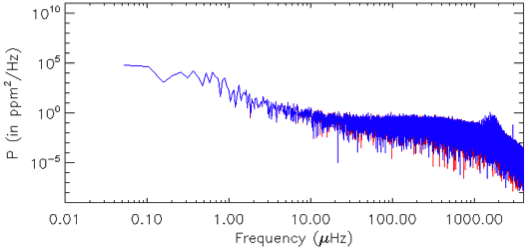Asteroseismology
Asteroseismology is the science that studies the internal structure of stars by the interpretation of their frequency spectra. Different oscillation modes penetrate to different depths inside the star. These oscillations can be used to obtain reliable information about stellar interiors and this has motivated a huge observational effort with the aim of doing asteroseismology.
Until recently, ground-based observations have been the primary source of the knowledge about oscillation modes in dierent types of pulsating stars. In the last decade, space missions like WIRE (Wide-eld InfraRed Explorer), MOST (Microvariability and Oscillations of STars), CoRoT (Convection, Rotation and Planetary Transits) or Kepler have made it possible to simultaneously record long time series on numerous targets. Nevertheless, ground-based networks such as SONG (Stellar Oscillations Network Group) can still be used in a complementary way to observe stars much brighter than the ones observed from space. All these missions have allowed us to study the internal structure of a lot of stars their dynamics, including internal rotation and their fundamental parameters such as their masses, radii, and ages.
The missing data problem
However, to be able to extract all the possible information on the stochastically excited oscillations of solar-like stars from the light curves, it is important to have continuous data without regular gaps. One important criterion for observational asteroseismology is the duty cycle. This is the measure of the fraction of time that is spent successively observing the variability of a given star. From the ground, for extended periods, even when instruments (or telescopes) from the same networks are deployed at different longitudes, the day/night cycle, the weather and other factors make it impossible to obtain continuous data sets. Normal duty cycles of ground based networks of several continuous months are typically below 90%. From space, most of these problems are overcome and duty cycles are commonly above 90%. However, even small time gaps can cause signicant confusion in the power spectrum. For example, the presence of repetitive gaps induced when a spacecraft, in a low Earth orbit, crosses the so-called South Atlantic Anomaly, may generate spurious peaks in the power spectrum, as it is the case for the CoRoT satellite (see below the power spectrum from the complete data (in blue) and from the incomplete data (in black).

Inpainting
Various methods have been developed to deal with gaps in time series data. We propose a new approach to handle the problem, the so-called inpainting method. This technique, based on a sparsity prior, enables to judiciously fill-in the gaps in the data, preserving the asteroseismic signal, as far as possible. This method can be applied both on ground and space-based data. It can be used to study very long time series of many stars because its computation is very fast. It appears that the inpainting technique improves the oscillation modes detection and estimation. In the figure below, we see the power spectrum from the complete data (inblue) and the result of the inpainting method (in red). As we can see, the impact of the observational window function (above) is significantly reduced and the interpretation of the power spectrum is simplified.

Applications on real data
- The Kepler asteroseismic Scientic Consortium has developed its own automated correction software to correct most of the light curves with a minimum human intervention. As a result of this study, the inpainting technique has been added to the pipeline to improve the asteroseismic studies.
- After the success of K-Inpainting in the Asteroseimic Kepler data, it has been decided to use the K-Inpainting method in the official CoRoT pipeline to correct the missing data in both asteroseismic and exoplanet channel.
